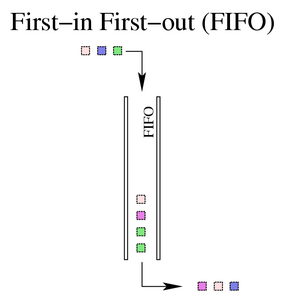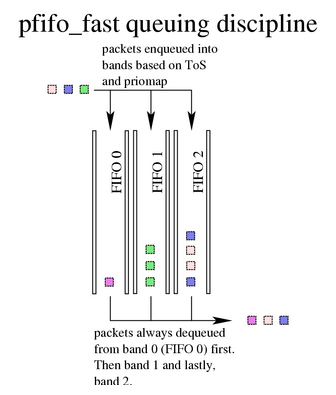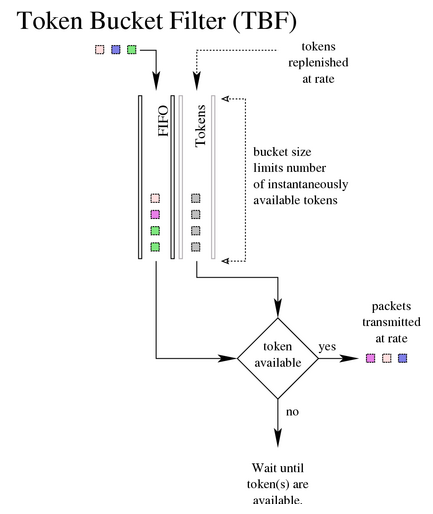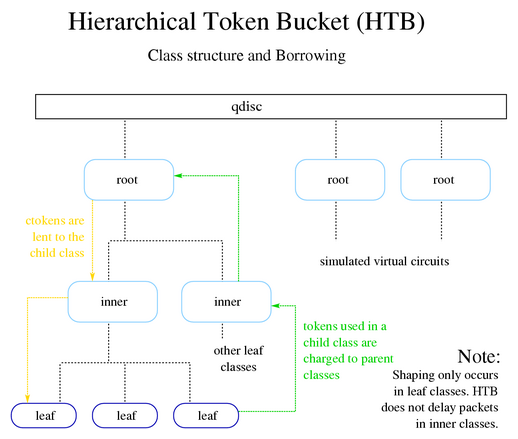TC简介
TC全称为Traffic Control,是Linux进行流量控制的工具。
更多的内容可阅读参考资料中的第一篇文章。
队列类型
Linux内核中支持的常见队列有:
- pfifo_fast: 先进先出队列


- TBF(Token Bucket Filter): 令牌桶过滤器

- SFQ(Stochastic Fairness Queueing): 随机公平队列

- HTB(Hierarchy Token Bucket): 分层令牌桶

TC应用场景
本节摘抄自Traffic Control HOWTO.
Common traffic control solutions
1. Limit total bandwidth to a known rate; TBF, HTB with child class(es).
2. Limit the bandwidth of a particular user, service or client; HTB classes and classifying with a filter. traffic.
3. Maximize TCP throughput on an asymmetric link; prioritize transmission of ACK packets, wondershaper.
4. Reserve bandwidth for a particular application or user; HTB with children classes and classifying.
5. Prefer latency sensitive traffic; PRIO inside an HTB class.
6. Managed oversubscribed bandwidth; HTB with borrowing.
7. Allow equitable distribution of unreserved bandwidth; HTB with borrowing.
8. Ensure that a particular type of traffic is dropped; policer attached to a filter with a drop action.
实践案例
pfifo_fast
pfifo_fast是系统默认的队列类型,只起到调度的作用,不对数据流量进行控制。
其中pfifo中的p是packet的缩写,表示queue的大小计量单位为packet。
可以通过ip命令查看当前网络队列设置
# ip link list
TBF
TBF队列通过设置令牌的产生速度来限制数据包的发送。
// 在eth0上设置一个tbf队列,网络带宽为200kbit,延迟50ms,缓冲区为1540个字节
// rate表示令牌的产生速率
// latency表示数据包在队列中的最长等待时间
// 对burst参数解释一下:
// burst means the maximum amount of bytes that tokens can be available for instantaneously.
// 如果数据包的到达速率与令牌的产生速率一致,即200kbit,则数据不会排队,令牌也不会剩余
// 如果数据包的到达速率小于令牌的产生速率,则令牌会有一定的剩余。
// 如果后续某一会数据包的到达速率超过了令牌的产生速率,则可以一次性的消耗一定量的令牌。
// burst就是用于限制这“一次性”消耗的令牌的数量的,以字节数为单位。
# tc qdisc add dev eth0 root tbf rate 200kbit latency 50ms burst 1540
# tc qdisc ls dev eth0 // 查看eth0上的队列规则
SFQ
SFQ队列通过一个hash函数将不同会话(如TCP流)分到不同的FIFO队列中,从而保证
数据流的公平性。
// perturb表示每10秒更新一次hash函数
# tc qdisc add dev eth0 root sfq perturb 10
HTB
// handle是一组用户指定的标示符,格式为major:minor。
// 如果是一条queueing discipline,minor需要一直为0。
# tc qdisc add dev eth0 root handle 1:0 htb
// parent指明该新增的class添加到那一个父handle上去
// classid指明该class handle的唯一ID,minor需要是非零值
// ceil定义rate的上界
# tc class add dev eth0 parent 1:1 classid 1:6 htb rate 256kbit ceil 512kbit
// 新建一个带宽为100kbps的root class, 其classid为1:1
# tc class add dev eth0 parent 1: classid 1:1 htb rate 100kbps ceil 100kbps
// 接着建立两个子class,指定其parent为1:1,ceil用来限制子类最大的带宽
# tc class add dev eth0 parent 1:1 classid 1:10 htb rate 40kbps ceil 100kbps
# tc class add dev eth0 parent 1:1 classid 1:11 htb rate 60kbps ceil 100kbps
// 随后建立filter指定哪些类型的packet进入那个class
# tc filter add dev eth0 protocol ip parent 1:0 prio 1 u32 match ip src 1.2.3.4 match ip dport 80 0xffff flowid 1:10
# tc filter add dev eth0 protocol ip parent 1:0 prio 1 u32 match ip src 1.2.3.4 flow 1:11
// 最后为这些class添加queuing disciplines
# tc qdisc add dev eth0 parent 1:10 handle 20: pfifo limit 5
# tc qdisc add dev eth0 parent 1:11 handle 30: sfq perturb 10
其他
// 同时模拟20Mbps带宽,50msRTT和0.1%丢包率
# tc qdisc add dev eth5 root handle 1:0 tbf rate 20mbit burst 10kb limit 300000
# tc qdisc add dev eth5 parent 1:0 handle 10:0 netem delay 50ms loss 0.1 limit 300000
Rules, Guidelines and Approaches
‘’’
A device can only shape traffic in transmits
HTB is an ideal qdisc to use on a link with a know bandwidth
In theory, the PRIO scheduler is an ideal match for links with variable bandwidth
Sharing/splitting bandwidth based on flows or IP
‘’’
参考资料
traffic-control:tc流量管理简介
Traffic Control HOWTO
HTB Linux queuing discipline manual - user guide